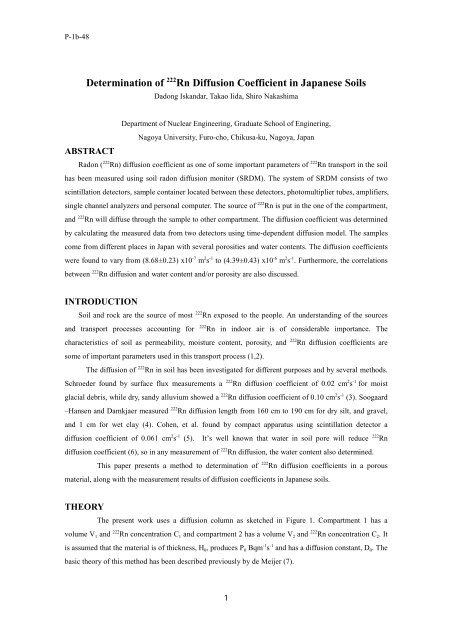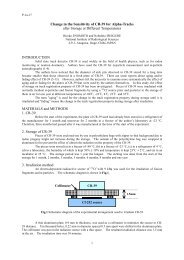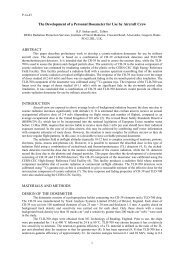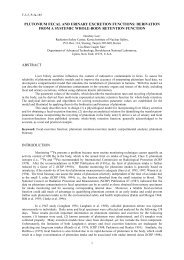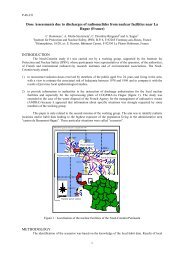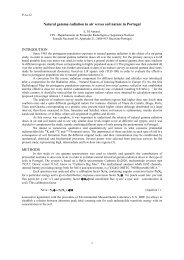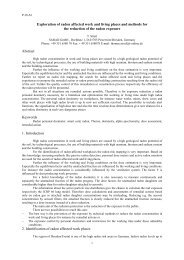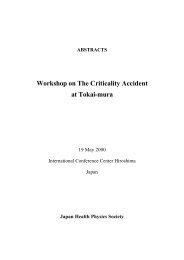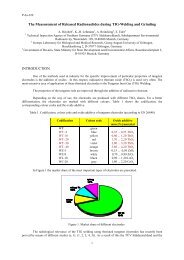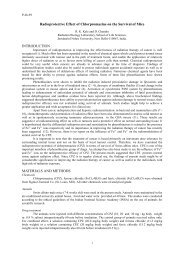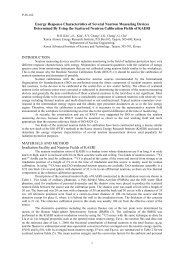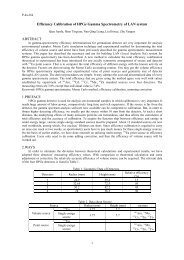Determination of 222 Rn Diffusion Coefficient in Japanese Soils
Determination of 222 Rn Diffusion Coefficient in Japanese Soils
Determination of 222 Rn Diffusion Coefficient in Japanese Soils
You also want an ePaper? Increase the reach of your titles
YUMPU automatically turns print PDFs into web optimized ePapers that Google loves.
P-1b-48<br />
<strong>Determ<strong>in</strong>ation</strong> <strong>of</strong> <strong>222</strong> <strong>Rn</strong> <strong>Diffusion</strong> <strong>Coefficient</strong> <strong>in</strong> <strong>Japanese</strong> <strong>Soils</strong><br />
Dadong Iskandar, Takao Iida, Shiro Nakashima<br />
ABSTRACT<br />
Department <strong>of</strong> Nuclear Eng<strong>in</strong>eer<strong>in</strong>g, Graduate School <strong>of</strong> Eng<strong>in</strong>er<strong>in</strong>g,<br />
Nagoya University, Furo-cho, Chikusa-ku, Nagoya, Japan<br />
Radon ( <strong>222</strong> <strong>Rn</strong>) diffusion coefficient as one <strong>of</strong> some important parameters <strong>of</strong> <strong>222</strong> <strong>Rn</strong> transport <strong>in</strong> the soil<br />
has been measured us<strong>in</strong>g soil radon diffusion monitor (SRDM). The system <strong>of</strong> SRDM consists <strong>of</strong> two<br />
sc<strong>in</strong>tillation detectors, sample conta<strong>in</strong>er located between these detectors, photomultiplier tubes, amplifiers,<br />
s<strong>in</strong>gle channel analyzers and personal computer. The source <strong>of</strong> <strong>222</strong> <strong>Rn</strong> is put <strong>in</strong> the one <strong>of</strong> the compartment,<br />
and <strong>222</strong> <strong>Rn</strong> will diffuse through the sample to other compartment. The diffusion coefficient was determ<strong>in</strong>ed<br />
by calculat<strong>in</strong>g the measured data from two detectors us<strong>in</strong>g time-dependent diffusion model. The samples<br />
come from different places <strong>in</strong> Japan with several porosities and water contents. The diffusion coefficients<br />
were found to vary from (8.68±0.23) x10 -7 m 2 s -1 to (4.39±0.43) x10 -6 m 2 s -1 . Furthermore, the correlations<br />
between <strong>222</strong> <strong>Rn</strong> diffusion and water content and/or porosity are also discussed.<br />
INTRODUCTION<br />
Soil and rock are the source <strong>of</strong> most <strong>222</strong> <strong>Rn</strong> exposed to the people. An understand<strong>in</strong>g <strong>of</strong> the sources<br />
and transport processes account<strong>in</strong>g for <strong>222</strong> <strong>Rn</strong> <strong>in</strong> <strong>in</strong>door air is <strong>of</strong> considerable importance. The<br />
characteristics <strong>of</strong> soil as permeability, moisture content, porosity, and <strong>222</strong> <strong>Rn</strong> diffusion coefficients are<br />
some <strong>of</strong> important parameters used <strong>in</strong> this transport process (1,2).<br />
The diffusion <strong>of</strong> <strong>222</strong> <strong>Rn</strong> <strong>in</strong> soil has been <strong>in</strong>vestigated for different purposes and by several methods.<br />
Schroeder found by surface flux measurements a <strong>222</strong> <strong>Rn</strong> diffusion coefficient <strong>of</strong> 0.02 cm 2 s -1 for moist<br />
glacial debris, while dry, sandy alluvium showed a <strong>222</strong> <strong>Rn</strong> diffusion coefficient <strong>of</strong> 0.10 cm 2 s -1 (3). Soogaard<br />
–Hansen and Damkjaer measured <strong>222</strong> <strong>Rn</strong> diffusion length from 160 cm to 190 cm for dry silt, and gravel,<br />
and 1 cm for wet clay (4). Cohen, et al. found by compact apparatus us<strong>in</strong>g sc<strong>in</strong>tillation detector a<br />
diffusion coefficient <strong>of</strong> 0.061 cm 2 s -1 (5). It’s well known that water <strong>in</strong> soil pore will reduce <strong>222</strong> <strong>Rn</strong><br />
diffusion coefficient (6), so <strong>in</strong> any measurement <strong>of</strong> <strong>222</strong> <strong>Rn</strong> diffusion, the water content also determ<strong>in</strong>ed.<br />
This paper presents a method to determ<strong>in</strong>ation <strong>of</strong> <strong>222</strong> <strong>Rn</strong> diffusion coefficients <strong>in</strong> a porous<br />
material, along with the measurement results <strong>of</strong> diffusion coefficients <strong>in</strong> <strong>Japanese</strong> soils.<br />
THEORY<br />
The present work uses a diffusion column as sketched <strong>in</strong> Figure 1. Compartment 1 has a<br />
volume V 1 and <strong>222</strong> <strong>Rn</strong> concentration C 1 and compartment 2 has a volume V 2 and <strong>222</strong> <strong>Rn</strong> concentration C 2 . It<br />
is assumed that the material is <strong>of</strong> thickness, H 0 , produces P 0 Bqm -1 s -1 and has a diffusion constant, D 0 . The<br />
basic theory <strong>of</strong> this method has been described previously by de Meijer (7).<br />
1
P-1b-48<br />
Compartment 2<br />
V2 C2<br />
Sample soil<br />
Co(z) Po<br />
Compartment 1<br />
V1 C1<br />
<strong>Rn</strong> source<br />
z<br />
z= Ho<br />
z=0<br />
Figure 1 The schematic cross section <strong>of</strong> diffusion chamber.<br />
The time dependent equation describ<strong>in</strong>g the concentration, C 0 , is given by Fick’s Law:<br />
dC<br />
dt<br />
0<br />
D<br />
0<br />
d<br />
2<br />
0<br />
2<br />
dz<br />
C<br />
+ P − λC<br />
= (1)<br />
where λ =the decay constant for <strong>222</strong> <strong>Rn</strong>.<br />
dC<br />
dt<br />
0 =<br />
0<br />
In steady state 0 and Eq.1 transforms <strong>in</strong>to:<br />
d<br />
2<br />
0<br />
2<br />
dz<br />
C<br />
C<br />
P<br />
0<br />
0<br />
− λ 0 = −<br />
(2)<br />
D0<br />
D0<br />
The boundary conditions at equilibrium are:<br />
C 0 (z=0)=C 1 and C 0 (z=H 0 )=C 2 (3)<br />
Eq (2) becomes<br />
d<br />
2<br />
0<br />
2<br />
dz<br />
with<br />
C<br />
C<br />
P<br />
0 0<br />
− = −<br />
(4)<br />
2<br />
l0<br />
D0<br />
2 D0<br />
l<br />
0 = ,<br />
0<br />
λ<br />
l =diffusion length.<br />
The solution <strong>of</strong> Eq.4 is given as:<br />
⎛ z ⎞ ⎛ z ⎞ P<br />
C0 () z As<strong>in</strong>h<br />
⎜ B cosh +<br />
l<br />
⎟<br />
⎜<br />
0<br />
l<br />
⎟<br />
⎝ ⎠ ⎝ 0 ⎠ λ<br />
0<br />
= +<br />
(5)<br />
From the boundary conditions <strong>in</strong> Eq.3 it follows that:<br />
C<br />
=<br />
C cosh β − P0 (1<br />
s<strong>in</strong>h β<br />
2 − 1<br />
−<br />
cosh β ) / λ<br />
A (6a)<br />
B<br />
C<br />
1<br />
P0<br />
−<br />
λ<br />
= with<br />
H<br />
=<br />
l<br />
0<br />
β (6b)<br />
0<br />
2
P-1b-48<br />
At equilibrium, the concentration C 2 is given by :<br />
E<br />
0<br />
A0<br />
λC2V2<br />
= (7)<br />
where E 0 is the exhalation from the area A 0 and is given as:<br />
E<br />
0<br />
⎡dC<br />
⎤<br />
D<br />
0<br />
= − 0 ⎢<br />
dz<br />
⎥<br />
(8)<br />
⎣ ⎦ z=<br />
H0<br />
Substitution <strong>of</strong> Eqs.5, 6 & 8 <strong>in</strong> Eq. 7 yields:<br />
C<br />
2<br />
( 1−<br />
cosh β )<br />
⎡ P0<br />
⎤<br />
A0l<br />
0 ⎢C1<br />
−<br />
λ ⎥<br />
⎣<br />
⎦<br />
V s<strong>in</strong>h β + A l cosh β<br />
= (9)<br />
2<br />
0 0<br />
EXPERIMENTAL PROCEDURE<br />
The Figure 2 shows the schematic diagram <strong>of</strong> soil radon diffusion monitor (SRDM). As<br />
shown <strong>in</strong> that figure, the parts <strong>of</strong> B 1 and B 2 are each a sta<strong>in</strong>less steel conta<strong>in</strong>er with a 20 cm diamater<br />
cyl<strong>in</strong>der <strong>of</strong> height 16 cm. The sample plate A with a 9 cm diameter cyl<strong>in</strong>der <strong>of</strong> height 16 cm is placed<br />
between these sta<strong>in</strong>less steel conta<strong>in</strong>er. The sections <strong>of</strong> C 1 and C 2 are the ZnS(Ag) sc<strong>in</strong>tillation detectors<br />
with diameter 5.2 cm <strong>of</strong> height 10 cm.<br />
F 2<br />
G 2<br />
H 2<br />
E<br />
2<br />
I<br />
C 2<br />
B 1<br />
,B 2<br />
S t<strong>in</strong> les s s te e l co n ta <strong>in</strong> e r<br />
D 2<br />
H 1<br />
A .S a m p l e p la t e<br />
C 1<br />
,C 2<br />
S c<strong>in</strong> tila tio n d e te cto r<br />
B 2<br />
D 1<br />
,D 2<br />
P h o t o m u l t i p l ie r T u b e<br />
E 1<br />
,E 2<br />
P re -a m p lifie r<br />
A F 1<br />
,F 2 L i n e a r A m p l i f ie r<br />
B 1<br />
G ,G 1 2<br />
S <strong>in</strong> g le ch a n n e l a n a ly z e r<br />
H 1<br />
,H 2<br />
I / F b o a r d<br />
C 1<br />
I<br />
P e r s o n a l C o m p u t e r<br />
D 1<br />
E 1<br />
F 1<br />
G 1<br />
Figure 2 Schematic <strong>of</strong> experimental set up.<br />
3
P-1b-48<br />
This SRDM was calibrated <strong>in</strong> radon calibration facility <strong>of</strong> Nagoya University. The SRDM was<br />
put <strong>in</strong> the 247.8 L calibration chamber, and <strong>222</strong> <strong>Rn</strong> concentration was measured by ionization chamber<br />
made by Ohkura Electric Co. Japan.<br />
The sample used <strong>in</strong> this experiment come from different places <strong>in</strong> Japan with several porosities,<br />
water contents, densities, and 226 Ra concentration. The characteristics <strong>of</strong> soil was determ<strong>in</strong>ed us<strong>in</strong>g the<br />
standard procedures as described by M.Nakano (8).<br />
The sample to be exam<strong>in</strong>ed was packed <strong>in</strong> the sample plate A, and <strong>222</strong> <strong>Rn</strong> source was put <strong>in</strong> the<br />
compartment 1. Then the compartment 1 and compartment 2 were tightly closed. By the time, <strong>222</strong> <strong>Rn</strong> will<br />
grow <strong>in</strong> the compartment 1, and after that it will diffuse through the sample to the compartment 2. The<br />
concentrations <strong>of</strong> <strong>222</strong> <strong>Rn</strong> <strong>in</strong> both compartments were measured every 1 hour for about 3 to 4 weeks. The<br />
diffusion coefficient <strong>of</strong> <strong>222</strong> <strong>Rn</strong> <strong>in</strong> the soil was calculated by the equation 9.<br />
RESULTS AND ANALYSIS<br />
Each experiment gave a curve <strong>of</strong> <strong>222</strong> <strong>Rn</strong> growth <strong>in</strong> the SRDM as shown <strong>in</strong> Figure 3, for example.<br />
This curve shows the <strong>222</strong> <strong>Rn</strong> concentration <strong>in</strong> the compartment 1 conta<strong>in</strong>s the <strong>222</strong> <strong>Rn</strong> source and <strong>in</strong> the<br />
compartment 2. Also it is shown the ratio between compartment 1 and compartment 2, which it is as the<br />
first <strong>in</strong>dication for the calculation <strong>of</strong> diffusion coefficient.<br />
Radon concentration (Bqm-3)<br />
50000<br />
45000<br />
40000<br />
35000<br />
30000<br />
25000<br />
20000<br />
15000<br />
10000<br />
5000<br />
0<br />
1<br />
0,9<br />
0,8<br />
0,7<br />
0,6<br />
0,5<br />
0,4<br />
0,3<br />
0,2<br />
0,1<br />
0<br />
0 100 200 300 400 500<br />
T i m e (hour)<br />
ratio <strong>of</strong> compartment 1 and 2<br />
compartment2<br />
compartment 1<br />
Ratio <strong>of</strong><br />
comp.1/comp.2<br />
Figure 3 Radon growth <strong>of</strong> the Okayama Prefecture soil sample at SRDM.<br />
The values <strong>of</strong> <strong>222</strong> <strong>Rn</strong> diffusion coefficients calculated from each measurement are listed <strong>in</strong> Table<br />
1 along with the soil characteristics as porosity and water content. The q factor def<strong>in</strong>ed as D/D air also is<br />
shown (D air = 1.1x10 -5 m 2 s -1 (9)). The correlation between the diffusion coefficient and soil porosity<br />
and/or soil moisture is shown <strong>in</strong> Figure 4.<br />
4
P-1b-48<br />
Table 1 The diffusion coefficients <strong>of</strong> <strong>222</strong> <strong>Rn</strong> <strong>in</strong> several <strong>Japanese</strong> soils.<br />
No. Material water content Porosity <strong>Diffusion</strong> coefficient q<br />
(%) (%) (m 2 s -1 ) (D/Dair)<br />
1. Sandy, Nagoya, Aichi Pref. 6 54 (1.61+0.09)x10-6 0.147<br />
2. Dry sandy, Fukui Pref. 0 64 (1.53+0.12)x10-6 0.139<br />
3. Sandy, Fukui Pref. 12 62 (8.68+0.23)x10-7 0.079<br />
4. Sandy, Okayama Pref. 17 44 (3.91+0.45)x10-6 0.355<br />
5. Sandy, Okayama Pref. 21 46 (2.99+0.32)x10-6 0.271<br />
6. Sandy, okayama Pref. 11 41 (4.39+0.43)x10-6 0.399<br />
5,2E-06<br />
70<br />
diffusion coefficient (m2s-1)<br />
4,7E-06<br />
4,2E-06<br />
3,7E-06<br />
3,2E-06<br />
2,7E-06<br />
2,2E-06<br />
1,7E-06<br />
1,2E-06<br />
60<br />
50<br />
40<br />
30<br />
20<br />
10<br />
Porosity or water content (%)<br />
<strong>Diffusion</strong> coefficient<br />
water content<br />
Porosity<br />
7,0E-07<br />
1 2 3 4 5 6<br />
Number <strong>of</strong> the sample<br />
0<br />
Figure 4 The correlation between diffusion coefficient and soil porosity and/or water content.<br />
In general, the diffusion coefficients reported by V.C.Rogers (6) is <strong>in</strong> the same range with the<br />
value <strong>in</strong> Table 1, but with Schroeder (2) and Soogard Hansen (3) are slightly lower. This can be described<br />
accord<strong>in</strong>g to the sample used <strong>in</strong> this paper was a raw materials. An exam<strong>in</strong>ation <strong>of</strong> these results shows a<br />
correlation between water content and <strong>222</strong> <strong>Rn</strong> diffusion coefficients.<br />
CONCLUSIONS<br />
The method used <strong>in</strong> this experiment has shown a good result to determ<strong>in</strong>e <strong>222</strong> <strong>Rn</strong> diffusion<br />
coefficients <strong>in</strong> the soil and other porous materials. The <strong>222</strong> <strong>Rn</strong> diffusion coefficients <strong>in</strong> the <strong>Japanese</strong> soils<br />
were found to vary from (8.68±0.23) x10 -7 m 2 s -1 to (4.39±0.43) x10 -6 m 2 s -1 . The values depend on the<br />
characteristics <strong>of</strong> the soil as water content and porosity.<br />
5
P-1b-48<br />
REFERENCES<br />
1. W.W. Nazar<strong>of</strong>f, B.A. Moed, R.G. Sextro, Soil as a Source <strong>of</strong> Indoor Radon: Generation, Migration,<br />
and Entry, In: W.W. Nazar<strong>of</strong>f and A.V.Nero,Jr., Radon and Its Decay Products <strong>in</strong> Indoor Air, John<br />
Wiley & Sons, New York (1988).<br />
2. A.B. Tanner, Radon Migration <strong>in</strong> the Ground: A supplementary review. In: T.F. Gessel, W.M. Lowder,<br />
eds. The Natural Radiation Environment III, Spr<strong>in</strong>gfield,VA: National Technical Information Service;<br />
CONF-780422 (1980).<br />
3. G.L.Schroeder, <strong>Diffusion</strong> <strong>of</strong> Radon <strong>in</strong> several Naturally occur<strong>in</strong>g Soil Types, J.Geophysical Research<br />
70, 471-474 (1965).<br />
4. J.Sogaard-Hansen and A.Damkjaer, Determ<strong>in</strong><strong>in</strong>g <strong>222</strong> <strong>Rn</strong> <strong>Diffusion</strong> Lengths <strong>in</strong> <strong>Soils</strong> and Sediments,<br />
Health Physics 53(5), 455-459 (1987).<br />
5. B.L. Cohen, J. Rakowski, R. Nason, A Simple Compact Apparatus for Measur<strong>in</strong>g <strong>Diffusion</strong> Properties<br />
<strong>of</strong> <strong>Rn</strong> Through <strong>Soils</strong> and Other Materials, Health Physics 50, 1, 133-137 (1986).<br />
6. V.C. Rogers and K.K. Nielson, Correlations for Predict<strong>in</strong>g Air Permeabilities and <strong>222</strong> <strong>Rn</strong> <strong>Diffusion</strong><br />
<strong>Coefficient</strong>s <strong>of</strong> <strong>Soils</strong>, Health Physics 61, 2, 225-230 (1991).<br />
7. R.J. de Meijer, T.D. Pugh, and M.B. Greenfield, Initial Steps towards Develop<strong>in</strong>g a Radon-Barrier<br />
Test Facility, Kernfysisch Versneller Instituut, Gron<strong>in</strong>gen, Netherland (1989).<br />
8. M.Nakano, T.Miyazaki, S.Shiozawa, and T.Nishimura, Physical and Environmental Analysis <strong>of</strong> <strong>Soils</strong>,<br />
University <strong>of</strong> Tokyo Press (1995) (<strong>in</strong> <strong>Japanese</strong>).<br />
9. K.K.Nielson, V.C. Rogers, and G.W.Gee, <strong>Diffusion</strong> <strong>of</strong> Radon through <strong>Soils</strong>: A Pore Distribution Model,<br />
Soil Sci. Soc. Am. J. 48:482-487 (1984).<br />
6


